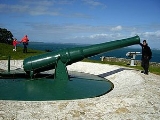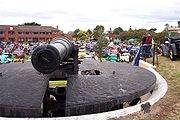
BL 8 inch Mk I - VII naval gun
Encyclopedia
The BL 8 inch guns Mark I to Mark VII were the first generations of British breech-loader
s of medium-heavy calibre. They were initially designed for gunpowder propellants and were of both 25.5 and 30 calibres lengths.
By 1885 the Royal Navy abandoned the 8-inch gun in favour of the 9.2 inch and later the 7.5 inch gun for cruisers, until 1923 when the restrictions of the Washington Naval Treaty
led Britain to develop the Mk VIII 8-inch gun
in order to arm heavy cruisers with the largest gun allowed by the Treaty.
In the interim Elswick Ordnance continued to develop 8-inch guns in 40 calibre and 45-calibre lengths for export, mainly to Japan.
and Australian and New Zealand coastal defences in response to expected Russian expansionism in the Pacific (The "Russian scares" of the 1880s).
 Mk VII guns armed the following Australian colonial gun vessels :
Mk VII guns armed the following Australian colonial gun vessels :
 Mk VII guns were installed on disappearing mountings
Mk VII guns were installed on disappearing mountings
in Australia and New Zealand as coast-defence guns during the "Russian scares" of the 1880s. In the event, no Russian invasion occurred and the guns were rarely if ever fired.
Four Mk VII coast defence guns were installed at Singapore in the 1880s-1890s : two atop Mount Serapong and two at Fort Tanjong Katong.
Breech-loading weapon
A breech-loading weapon is a firearm in which the cartridge or shell is inserted or loaded into a chamber integral to the rear portion of a barrel....
s of medium-heavy calibre. They were initially designed for gunpowder propellants and were of both 25.5 and 30 calibres lengths.
History
Mks I and II were several early proof guns that did not enter British service and Mk V was not made. Limited numbers of 25.5 and 30 calibres guns were produced.By 1885 the Royal Navy abandoned the 8-inch gun in favour of the 9.2 inch and later the 7.5 inch gun for cruisers, until 1923 when the restrictions of the Washington Naval Treaty
Washington Naval Treaty
The Washington Naval Treaty, also known as the Five-Power Treaty, was an attempt to cap and limit, and "prevent 'further' costly escalation" of the naval arms race that had begun after World War I between various International powers, each of which had significant naval fleets. The treaty was...
led Britain to develop the Mk VIII 8-inch gun
BL 8 inch Mk VIII naval gun
The 50 calibre BL 8 inch gun Mark VIII was the main battery gun used on the Royal Navy's County-class heavy cruisers, in compliance with the Washington Naval Treaty of 1922. This treaty allowed ships of not more than 10,000 tons standard displacement and with guns no larger than 8 inches to be...
in order to arm heavy cruisers with the largest gun allowed by the Treaty.
In the interim Elswick Ordnance continued to develop 8-inch guns in 40 calibre and 45-calibre lengths for export, mainly to Japan.
Mark III
Mk III were low-powered 25-calibres guns mounted on :- HMS Bellerophon (1865)HMS Bellerophon (1865)HMS Bellerophon was a central battery ironclad built for the Royal Navy in the mid-1860s.-Design and description:In this ship, designed by Sir Edward Reed, the power-to-weight ratio was increased; the long rows of guns on the broadside were replaced by a small number of guns, centrally placed, of...
as re-gunned in 1885
Mark IV
Mk IV were 30-calibres guns mounted in :- Mersey class protected cruisers of 1885
Mark VI
Mk VI were 30 calibres guns mounted in :- Indian Monitors HMS Abyssinia (1870)HMS Abyssinia (1870)HMS Abyssinia was a breastwork monitor ordered, designed and built by J & W Dudgeon specifically for the Bombay Marine for the defence of the harbour at Bombay....
and HMS Magdala (1870)HMS Magdala (1870)HMS Magdala was a breastwork monitor of the Royal Navy, built specifically to serve as a coastal defence ship for the harbour of Bombay in the late 1860s. She was ordered by the India Office for the Bombay Marine. The original specifications were thought to be too expensive and a cheaper design...
as re-gunned in 1892
Mark VII
Mk VII were lighter 25-calibres low-powered guns firing a lighter 180-pound projectile used to equip Australian colonial naviesColonial navies of Australia
Before Federation in 1901 five of the six separate colonies maintained their own naval forces for defence. The colonial navies were supported by the ships of the Royal Navy’s Australian Station which was established in 1859...
and Australian and New Zealand coastal defences in response to expected Russian expansionism in the Pacific (The "Russian scares" of the 1880s).
Naval service

- HMQS GayundahHMQS GayundahHMQS Gayundah was a flat-iron gunboat operated by the Queensland Maritime Defence Force and later the Royal Australian Navy . She entered service in 1884 and was decommissioned and sold in 1921. She then served as sand and gravel barge for Brisbane Gravel Pty Ltd until 1950, when she was scrapped...
of 1884 - HMCS ProtectorHMAS Protector (1884)HMCS/HMAS Protector was a large flat-iron gunboat commissioned and purchased by the South Australian government in 1884, for the purpose of defending the local coastline against possible attacks in the aftermath of the ‘Russian scare', of 1870s...
of 1884 - HMVS AlbertHMVS AlbertHMVS Albert was a gunboat of the Victorian Naval Forces which was requisitioned for service with the Royal Australian Navy during World War I.-Operational history:HMVS Albert was built by Armstrong, Mitchell and Co. of Elswick, United Kingdom...
of 1884 - HMVS VictoriaHMVS Victoria (II)HMVS Victoria was a gunboat that served with the Victorian Naval Forces and Western Australia before being sold into private use.-Design:This class was built to a type D flat-iron gunboat design from builders Armstrong Mitchell and Co....
of 1884
Coast defence gun

Disappearing gun
A disappearing gun is a type of heavy artillery for which the gun carriage enabled the gun to rotate backwards and down into a pit protected by a wall or a bunker after it was fired...
in Australia and New Zealand as coast-defence guns during the "Russian scares" of the 1880s. In the event, no Russian invasion occurred and the guns were rarely if ever fired.
Four Mk VII coast defence guns were installed at Singapore in the 1880s-1890s : two atop Mount Serapong and two at Fort Tanjong Katong.
Surviving examples
- Mk VII at North HeadNorth Head, New ZealandNorth Head is a volcanic cone forming a headland within North Shore City, New Zealand, in the suburb of Devonport at the east end of the Waitemata Harbour ....
, Devonport, New ZealandDevonport, New ZealandDevonport is a harbourside suburb of Auckland, New Zealand. It is located on the North Shore, at the southern end of a peninsula that runs southeast from near Lake Pupuke in Takapuna, forming the northern side of the Waitemata Harbour... - Mk VII at summit of Mount Victoria, AucklandMount Victoria, AucklandMount Victoria is the highest volcano on Auckland's North Shore, rising to 87 m. Its age is currently unknown. Its lava flows now line much of Devonport's waterfront...
, New Zealand - An unrestored Mk VII disappearing gun at Fort Jervois, Ripapa Island, New Zealand
- Mk VII at Fort Siloso, Sentosa Island, Singapore See also Photograph at Flickr
- Mk VII at Royal Artillery Museum, Woolwich, London
- A Mk VII gun from 1885 on hydro-pneumatic mounting at Fort QueenscliffFort QueenscliffFort Queenscliff, in Victoria, Australia, dates from 1860 when an open battery was constructed on Shortland's Bluff to defend the entrance to Port Phillip. The Fort, which underwent major redevelopment in the late 1870s and 1880s, became the headquarters for an extensive chain of forts around Port...
, VIC, Australia
External links
- Instructions for 8 inch Rifled Breech Loading Armstrong Gun and Hydro-Pneumatic Disappearing Carriage Describes Mk VII gun. From Australian National Archives
- Instructions for 8 inch Rifled Breech Loading Armstrong Gun and Naval Carriage and Slide Describes Mk VII gun. From Australian National Archives

